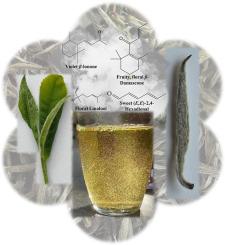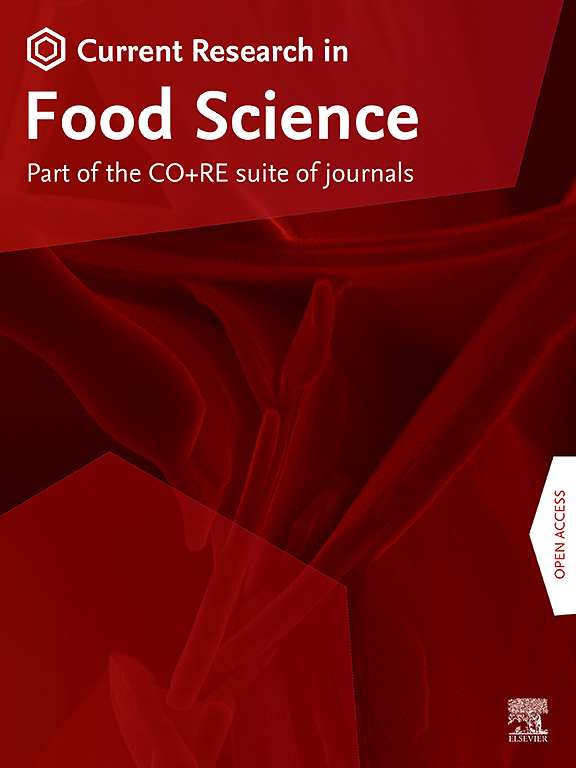Volatile metabolomics highlights tea trichome's positive contribution to aroma and quality of white tea
IF 7
2区 农林科学
Q1 FOOD SCIENCE & TECHNOLOGY
引用次数: 0
Abstract
Tea trichomes, rich in secondary metabolites, are hypothesized to significantly influence white tea aroma, yet their biochemical contributions remain unclear. This study investigated the volatile profiles of tea trichome and tea body across six white tea samples using headspace solid-phase microextraction combined with gas chromatography-mass spectrometry (HS-SPME-GC-MS) and multivariate statistical analysis. Comparative analysis revealed significant differences in the volatile profile between tea trichome and tea body in all tested samples, with major differences lying in the content of volatile components. Sixteen potential key aroma components with relative odor activity value (ROAV) ≥ 1 and 39 aroma modifiers (0.1<ROAV<1) were identified in both tea trichome and tea body, predominantly associated with green, fruity, sweet, floral, woody and herbal aroma. In brief, trans-β-ionone, β-damascone, linalool, non-8-enal and (E,Z)-2,6-nonadienal were identified as key aroma components in both tea trichome and tea body, determining the basic aroma characteristic of white tea. Aroma modifiers were also affirmed, including β-myrcene, 2-ethyl-3,5-dimethyl-pyrazine, (E)-2-hexenal, dehydro-β-ionone, (Z)-6-nonenal, (E,E)-2,4-decadienal and benzeneacetaldehyde, which were shared by all samples in tea trichome and tea body. Notably, most of these key and modified aroma components showed higher relative contents and ROAVs in tea trichome than those in tea body. These data reveals that tea trichome positively enhance white tea's aroma quality, notably intensifying fruity, floral, sweet, green, and woody notes. This study systematically clarifies the biochemical specificity of tea trichome and their positive impact on white tea aroma, highlighting their critical role in aroma formation through differential accumulation of aroma contributors.

挥发性代谢组学强调了茶毛对白茶香气和品质的积极贡献
茶毛状体富含次生代谢物,被认为对白茶香气有显著影响,但其生化贡献尚不清楚。采用顶空固相微萃取-气相色谱-质谱联用技术和多元统计分析方法,研究了6种白茶样品中茶毛和茶体的挥发性特征。对比分析表明,所有样品中茶毛体和茶体的挥发性成分存在显著差异,主要差异在于挥发性成分的含量。在茶毛和茶体中均鉴定出16种相对气味活性值(ROAV)≥1的潜在关键香气成分和39种香气调节剂(0.1<ROAV<1),主要与绿色、果味、甜味、花香、木质和草本香气相关。总之,反式β-ionone、β-damascone、芳樟醇、非8-烯醛和(E,Z)-2,6-非二烯醛被确定为茶毛和茶体的关键香气成分,决定了白茶的基本香气特征。香气调节剂包括β-月桂烯、2-乙基-3,5-二甲基吡嗪、(E)-2-己烯醛、脱氢-β-离子酮、(Z)-6-壬烯醛、(E,E)-2,4-十烯醛和苯乙醛,它们在茶毛体和茶体中具有共享性。值得注意的是,这些关键和修饰的香气成分在茶毛体中的相对含量和roav均高于茶体。这些数据表明,茶毛对白茶的香气质量有积极的增强作用,特别是增强了水果、花香、甜味、绿色和木质的味道。本研究系统阐明了茶毛状体的生化特异性及其对白茶香气的积极影响,强调了茶毛状体通过香气因子的差异性积累在香气形成中的关键作用。
本文章由计算机程序翻译,如有差异,请以英文原文为准。
求助全文
约1分钟内获得全文
求助全文
来源期刊

Current Research in Food Science
Agricultural and Biological Sciences-Food Science
CiteScore
7.40
自引率
3.20%
发文量
232
审稿时长
84 days
期刊介绍:
Current Research in Food Science is an international peer-reviewed journal dedicated to advancing the breadth of knowledge in the field of food science. It serves as a platform for publishing original research articles and short communications that encompass a wide array of topics, including food chemistry, physics, microbiology, nutrition, nutraceuticals, process and package engineering, materials science, food sustainability, and food security. By covering these diverse areas, the journal aims to provide a comprehensive source of the latest scientific findings and technological advancements that are shaping the future of the food industry. The journal's scope is designed to address the multidisciplinary nature of food science, reflecting its commitment to promoting innovation and ensuring the safety and quality of the food supply.
 求助内容:
求助内容: 应助结果提醒方式:
应助结果提醒方式:


